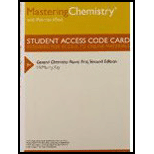
Concept explainers
Conceptual PRACTICE 2.1 An element is a shiny, silver-colored solid at room temperature and pressure. It conducts electricity and can be found in nature in its pure form. Classify the element as a metal, nonmetal, or semimetal and specify its general location in the periodic table.
To determine:
If the element is metal, nonmetal or semimetal due to its properties.
Locate the element in periodic table.
Answer to Problem 2.1P
Solution:
This is a metal.
Most metals are present in transition metal group or Families IA and IIA (left of the table).
Explanation of Solution
When classifying elements, there are three main groups to choose from. The metals, which have good heat and electricity conductivities, they are malleable and ductile. Typically, they are very shiny and solids at room temperature.
Since the species is shiny, solid and conducts electricity, this is most likely a metal.
Metals are present on the “left” side of the periodic table. They are present in Groups IA, IIA, and transition metal group.
This is a metal, and it will be placed on the left side of the table.
Want to see more full solutions like this?
Chapter 2 Solutions
Chemistry-Masteringchemistry With Etext
Additional Science Textbook Solutions
Organic Chemistry (9th Edition)
General Chemistry: Principles and Modern Applications (11th Edition)
Organic Chemistry (8th Edition)
Organic Chemistry
CHEMISTRY-TEXT
Essential Organic Chemistry (3rd Edition)
- Given that the periodic table is an organizational scheme for the elements, what might be some other logical ways in which to group the elements that would provide meaningful chemical information in a periodic table of your own devising?arrow_forwardWhat defines an element? How many naturally occurring elements exist?arrow_forwardWhat is the name of the element in Group 4A and Period 5?arrow_forward
- 2.40 What distinguished the work of Mendeleev that caused scientists to accept his concept of the periodic table when others before him were not believed?arrow_forwardFrom the following written description, write the balanced chemical equation for the reaction including state symbols. A diatomic gaseous molecule that contains 17 protons per atom is reacted with a solid element that has an atomic number of 19 to yield an ionic compound.arrow_forwardIn a hypothetical universe, an oil-drop experiment gave the following measurements of charges on oil drops: 5.55 1019 C, 9.25 1019 C, 1.11 1018 C, and 1.48 1018 C. Assume that the smallest difference in charge equals the unit of negative charge in this universe. What is the value of this unit of charge? How many units of excess negative charge are there on each oil drop?arrow_forward
- The following table presents the abundances and masses of the isotopes of zinc. What is the atomic weight of zinc?arrow_forwardUsing the information in Table 2.1, answer the following questions. In an ion with an unknown charge, the total mass of all the electrons was determined to be 2.55 1026 g. while the total mass of its protons was 5.34 1023 g. What is the identity and charge of this ion? What is the symbol and mass number of a neutral atom whose total mass of its electrons is 3.92 1026 g, while its neutrons have a mass of 9.35 1023 g?arrow_forwardHow is an atom’s atomic number related to its number ofprotons? To its number of electrons?arrow_forward
- Chemistry: Matter and ChangeChemistryISBN:9780078746376Author:Dinah Zike, Laurel Dingrando, Nicholas Hainen, Cheryl WistromPublisher:Glencoe/McGraw-Hill School Pub Co
 Chemistry for Engineering StudentsChemistryISBN:9781337398909Author:Lawrence S. Brown, Tom HolmePublisher:Cengage Learning
Chemistry for Engineering StudentsChemistryISBN:9781337398909Author:Lawrence S. Brown, Tom HolmePublisher:Cengage Learning Introductory Chemistry: A FoundationChemistryISBN:9781337399425Author:Steven S. Zumdahl, Donald J. DeCostePublisher:Cengage Learning
Introductory Chemistry: A FoundationChemistryISBN:9781337399425Author:Steven S. Zumdahl, Donald J. DeCostePublisher:Cengage Learning  Chemistry for Engineering StudentsChemistryISBN:9781285199023Author:Lawrence S. Brown, Tom HolmePublisher:Cengage Learning
Chemistry for Engineering StudentsChemistryISBN:9781285199023Author:Lawrence S. Brown, Tom HolmePublisher:Cengage Learning General Chemistry - Standalone book (MindTap Cour...ChemistryISBN:9781305580343Author:Steven D. Gammon, Ebbing, Darrell Ebbing, Steven D., Darrell; Gammon, Darrell Ebbing; Steven D. Gammon, Darrell D.; Gammon, Ebbing; Steven D. Gammon; DarrellPublisher:Cengage Learning
General Chemistry - Standalone book (MindTap Cour...ChemistryISBN:9781305580343Author:Steven D. Gammon, Ebbing, Darrell Ebbing, Steven D., Darrell; Gammon, Darrell Ebbing; Steven D. Gammon, Darrell D.; Gammon, Ebbing; Steven D. Gammon; DarrellPublisher:Cengage Learning World of Chemistry, 3rd editionChemistryISBN:9781133109655Author:Steven S. Zumdahl, Susan L. Zumdahl, Donald J. DeCostePublisher:Brooks / Cole / Cengage Learning
World of Chemistry, 3rd editionChemistryISBN:9781133109655Author:Steven S. Zumdahl, Susan L. Zumdahl, Donald J. DeCostePublisher:Brooks / Cole / Cengage Learning





